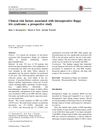Intraoperative Floppy Iris Syndrome: Updated Perspectives
February 2020
in “
Clinical Ophthalmology
”

TLDR Certain medications and patient factors increase the risk of Intraoperative Floppy Iris Syndrome during cataract surgery, but with careful planning and technique adjustments, complications can be minimized.
Intraoperative Floppy Iris Syndrome (IFIS) presents a significant challenge during cataract surgery, with a reported prevalence between 1.1% and 12.6%. The syndrome is associated with the use of certain medications, including tamsulosin, other α1-adrenergic receptor antagonists, finasteride, angiotensin II receptor inhibitors, benzodiazepines, antipsychotics, and hypertension drugs, as well as patient factors such as gender, age, and decreased dilated pupil diameter. The document emphasizes the importance of preoperative risk assessment to identify patients at risk and recommends preoperative prophylaxis and surgical technique modifications for high-risk patients to minimize complications. Discontinuing certain medications preoperatively does not completely prevent IFIS, suggesting the need for further research into its pathophysiological mechanisms. The review also calls for a multidisciplinary approach and increased awareness among healthcare professionals about the risks of medications that can induce IFIS. Despite the challenges, with proper preoperative assessment and management, the risk of complications from IFIS can be reduced to baseline levels.









